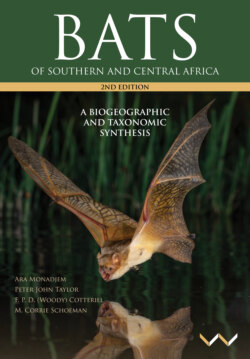Читать книгу Bats of Southern and Central Africa - Ara Monadjem - Страница 25
На сайте Литреса книга снята с продажи.
ROOSTING HABITS
ОглавлениеDifferent species of bats roost in various places during the day, such as among foliage, in hollows or crevices, and in specialised roosts, notably caves (Figures 13, 14, 18).
Figure 13. Different views (a, b, c) of one of the bat houses in Letaba Campsite, Kruger National Park. These bat houses provide alternative roosts for molossid bats, which likely control insect populations, including mosquitoes (© F. P. D. Cotterill).
Figure 14. Schematic comparison of the diversity of different daylight domiciles selected by representative species of African Chiroptera that roost in trees: A free-hanging from main boughs, Eidolon helvum; B clinging under exfoliating bark, Laephotis spp., Nycticeinops schlieffeni, and Pipistrellus spp.; C clinging within foliage, reliant on crypsis, Glauconycteris variegata; D clinging within cracks within an elephant-damaged branch, Chaerephon chapini; E clinging in hollow branches, Chaerephon pumilus; F free-hanging in large cavity of tree trunk, Nycteris grandis; G clinging on tree trunk, Taphozous mauritianus; H free-hanging under exposed roots, Nycteris spp.; I sheltering under elephant-stripped bark, Taphozous mauritianus; J deep in dense foliage, Scotoecus spp.; K free-hanging in shrubs, Lavia frons; L inside disused bird nests or spider nests, Kerivoula spp.; M in hollow boles high up in tree, Mops condylurus and M. niveiventer; N under exfoliating bark, Chaerephon nigeriae; O in narrow holes, small-bodied Molossidae (modified after Verschuren (1957a) and Brosset (1966a) with addition of unpublished data, F. P. D. Cotterill).
